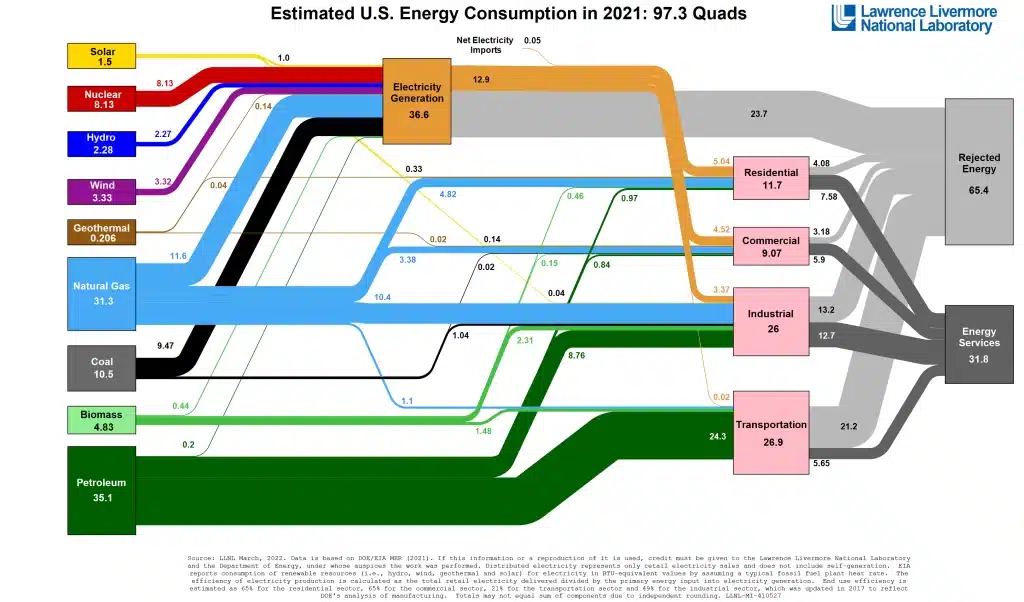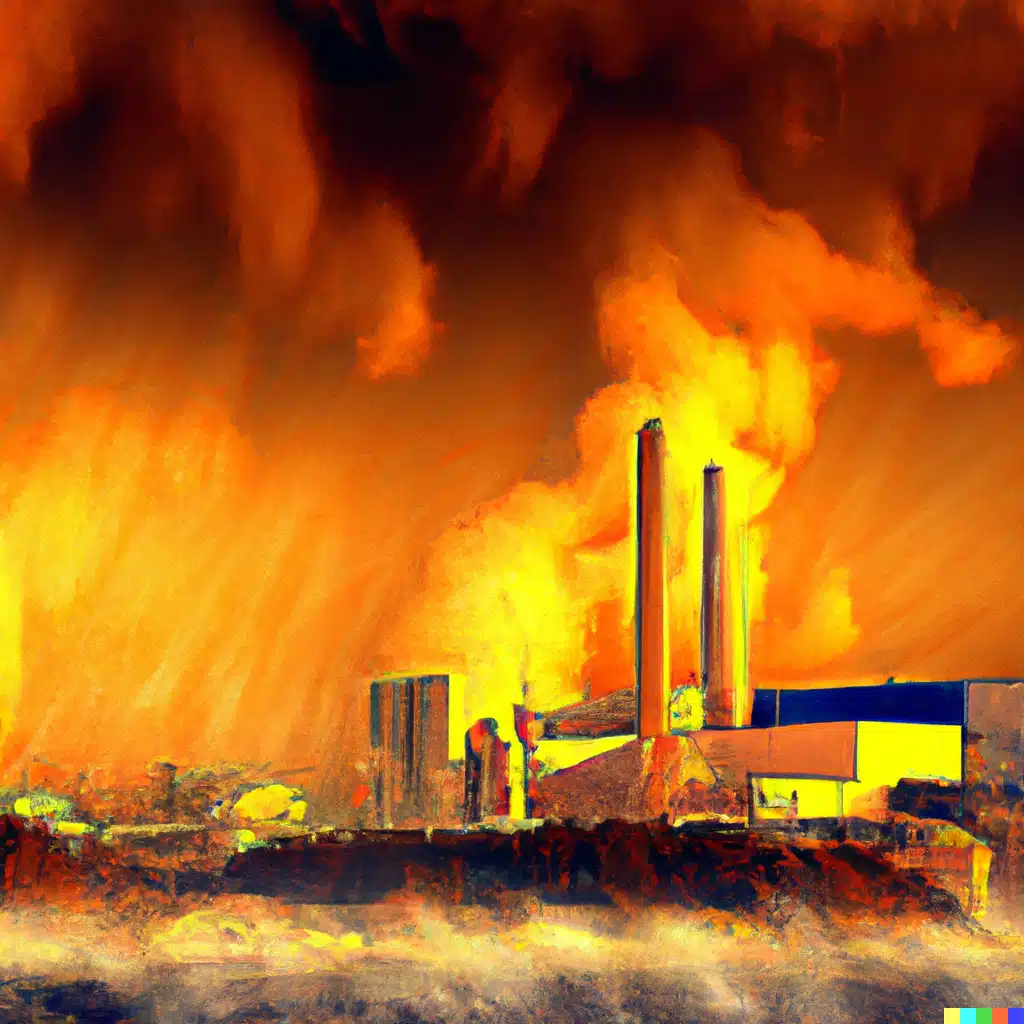This article was mostly written by ChatGPT. More on that at the end of the article.
Rejected energy is a type of energy that is not used or is wasted during the production or consumption of other forms of energy. ChatGPT and I believe that rejected energy is an often-overlooked source of clean and renewable energy that has the potential to make a significant contribution to meeting global energy demand in a sustainable manner as we transition to much lower rejected energy over the coming decades. With the growing focus on clean technology and the need to reduce greenhouse gas emissions, it is important to consider the use of rejected energy as a means to achieve these goals.
In this article, ChatGPT and I will define rejected energy, provide examples of its common sources, discuss the ways in which it can be used, outline the benefits of using rejected energy, and address the challenges and limitations of doing so. This is a complement to getting rid of most rejected energy through electrification and shifting to renewables, a subject I covered in an article recently.

The LLNL energy flow Sankey diagrams are graphical representations of the flows of energy in a given system or region. They are widely used in the energy industry and by researchers and policy makers to understand and analyze energy flows and to identify opportunities for improving energy efficiency and reducing energy waste. The diagrams show the inputs, outputs, and sources of energy in a system and can be used to identify areas where energy is being wasted or lost. The LLNL energy flow diagrams are often used to study the energy flows in countries, states, and regions, as well as in specific sectors, such as the transportation or electricity generation sectors.
Sankey diagrams, which are also known as flow diagrams, were first introduced in the late 1800s by Irish engineer and captain Matthew Henry Phineas Riall Sankey. Sankey originally developed the diagrams as a means to visualize the energy efficiency of steam engines, and used them to show the heat and work inputs and outputs of the engines. The diagrams became known as Sankey diagrams in his honor, and have since been used to visualize the flow of energy, materials, and other quantities in a variety of systems. Today, Sankey diagrams are used in a range of fields, including energy, engineering, economics, and the environment, to understand and analyze the flows of energy and other quantities.
One example of how the LLNL energy flow diagrams are used is to study the energy flows in a specific region or country. By analyzing the energy flows in a region, it is possible to identify the sources of energy being used and the ways in which energy is being used, as well as to identify opportunities for improving energy efficiency and reducing energy waste. For example, a study using the LLNL energy flow diagrams may show that a significant portion of the energy used in a region is being wasted or lost through inefficiencies in the transportation or electricity generation sectors. This information can be used to inform policy and decision making in order to improve energy efficiency and reduce energy waste.
In the LLNL energy flow diagrams, rejected energy is shown as a separate category or flow of energy in light gray. The diagrams show the inputs, outputs, and sources of energy in a system, and rejected energy is typically shown as a source of energy that is not being fully utilized or is being wasted. Note that for 2021, about two-thirds of all primary energy inputs were rejected, that is thrown away without be of any use.
One benefit of using rejected energy is the reduction of energy consumption. By capturing and using energy that would otherwise be wasted, it is possible to reduce the amount of energy that is needed from primary sources, such as coal, oil, and natural gas. This can lead to a decrease in the overall demand for these primary energy sources, which can have a positive impact on the environment and on energy security.
Another benefit of using rejected energy is the decrease in greenhouse gas emissions. Many primary energy sources, such as coal and natural gas, are associated with high levels of greenhouse gas emissions when they are extracted, produced, and consumed. By using rejected energy, it is possible to reduce the amount of energy that is generated from these sources, which can lead to a decrease in greenhouse gas emissions.
Finally, using rejected energy can improve energy efficiency by reducing energy waste and making more efficient use of the energy that is generated. By capturing and using energy that would otherwise be wasted, it is possible to increase the overall efficiency of energy systems and to make better use of the energy that is available. This can lead to cost savings and other benefits for individuals, businesses, and society as a whole.
One criticism of the LLNL energy flow diagrams is that they do not fully account for the environmental impacts of energy production and consumption. The diagrams show the flows of energy, but they do not take into account the environmental impacts of extracting, producing, and using energy, such as air pollution and greenhouse gas emissions. Another criticism is that the diagrams do not fully capture the complexity of energy systems and may oversimplify the flows of energy. Finally, some have argued that the diagrams do not adequately reflect the role of energy storage in energy systems, as storage is often an important component of modern energy systems.
There are several ways in which rejected energy can be used to generate electricity or other forms of energy. One common method is through the use of waste heat recovery systems, which capture the heat that is normally wasted during industrial processes and use it to generate electricity. Another method is through the use of combined heat and power (CHP) systems, which generate electricity and useful heat simultaneously by capturing the heat that is normally wasted in power plants. Thermoelectric generators are also used to convert rejected heat into electricity. These generators use temperature differences to generate electricity and are often used in vehicles and portable devices.
District heating systems are a type of energy infrastructure that can take advantage of rejected energy in order to provide heating and hot water to buildings in a specific area, such as a neighborhood or a district. These systems typically use a central heating plant to generate heat, which is then distributed to buildings through a network of underground pipes. The heat can be generated from a variety of sources, including rejected energy. For example, a district heating system may use waste heat from a power plant, industrial processes, or other sources to generate heat for the district.
There are several challenges and limitations to using rejected energy. One challenge is the high upfront costs of implementing waste heat recovery systems, CHP systems, and thermoelectric generators. These systems require significant investment in order to be installed and operated, which can be a barrier to their use. There are also technical difficulties associated with using rejected energy, such as the need to effectively capture and transport the heat or electricity that is generated.
Finally, there are regulatory and policy barriers that can limit the use of rejected energy. These barriers can take the form of policies that favor the use of primary energy sources over rejected energy, as well as regulatory frameworks that do not adequately support the use of rejected energy. For example, some countries or regions may have policies that provide subsidies or other incentives for the use of primary energy sources, such as coal, oil, and natural gas. These policies can make it more difficult for rejected energy sources to compete, as they may not receive the same level of support. In addition, regulatory frameworks that do not adequately recognize or support the use of rejected energy can be a barrier to its adoption. For example, if there are no regulations or policies in place to encourage the use of rejected energy, it may be difficult for individuals or businesses to justify the investment in technologies or systems that capture and use rejected energy. Overcoming these policy and regulatory barriers will be an important step in increasing the use of rejected energy as a clean and renewable energy source.
Despite these challenges and limitations, the use of rejected energy has the potential to make a significant contribution to meeting global energy demand in a sustainable manner. As such, it is important to continue exploring and developing technologies and policies that support the use of rejected energy. In conclusion, rejected energy is a valuable and often-overlooked source of clean and renewable energy that has the potential to reduce energy consumption, decrease greenhouse gas emissions, and improve energy efficiency.
Rejected energy is a valuable and often-overlooked source of clean and renewable energy that has the potential to make a significant contribution to meeting global energy demand in a sustainable manner. By capturing and using energy that would otherwise be wasted, it is possible to reduce energy consumption, decrease greenhouse gas emissions, and improve energy efficiency. While there are challenges and limitations to using rejected energy, such as high upfront costs and technical difficulties, the potential benefits of doing so make it an important consideration in the transition to a clean energy future. As such, it is important to continue exploring and developing technologies and policies that support the use of rejected energy.
And now, some comments on ChatGPT helping me write this article. Virtually everything above this was written by ChatGPT with questions and iterations directed by me and some light editing and insertions, including the title options I provided to CleanTechnica’s editors. Everything below the including this sentence was written by me, but I fed it through ChatGPT and asked it to remove any typos. I write like Usain Bolt runs, but couldn’t have generated this much grammatically correct, contextualized prose with as few typos in the same amount of time. Just ask CleanTechnica editors (and sharp-eyed readers).
For those who haven’t been paying attention to it, and if you write anything or have others write it for you you should be paying attention, ChatGPT is a natural language tool from the OpenAI firm which you interact with as if you are chatting with a writer and researcher. You can ask it to describe how to structure some content, you can provide it prompts about language to use (it liked “utilize” and its variants, which got right up my nose), you can provide something that’s already written and ask it to somewhat copy the style, you can ask it to write in bullet points or paragraphs, you can ask it to expand on sections, or write specific paragraphs and the like. You can also ask it to rewrite a section using “ChatGPT and I” instead of “we,” and it will do it, as per the first paragraph.
Everything you do in the session will be remembered. And when the session ends, it’s over, so you have to start again for the next piece.
It doesn’t add hyperlinks or references, and doesn’t draw pictures. But if you ask it what diagrams would be useful, it lists a bunch with text sufficient to find variants of them in Google, or to ask the DALL-E AI image creation tool to draw one for you, like the image of a house recovering heat from waste water that tops this article. Or this one of a factory venting waste heat. Or pixelated. Or 3D renders. Or digital art. Note: there are zero copyright concerns on DALL-E-generated diagrams and there are lots of style choices.

A couple of years ago, CleanTechnica published my report on machine learning and clean technology. ChatGPT and DALL-E are outgrowths of that type of work, using neural nets on GPUs with advanced data science and existing visual and textual libraries to work their magic. One of the challenges I faced then was finding freely usable illustrations and pictures for the plastic dinosaur theme stories that introduced the sections, providing a narrative hook to hang concepts like salience off of. Well, DALL-E came to the rescue today.

How can you take advantage of this as a clean energy investor, business person, or advocate? Well, you can get high-quality, informed, logical, and well-written text and decorative images for your pitches, proposals, RFPs, grant submissions, patent submissions, blogs, newsletters, and social media posts quickly and cheaply. You have to learn how to ask ChatGPT questions, work within or around its built-in constraints, and expand or contract as necessary, but it provides pretty good text that is factually based really quickly.
However, be aware that some places are getting strange about computer-generated content. For example, one of the top AI conferences, where ChatGPT is one of the primary things presented on and discussed, has established guidelines that state nothing in submissions can be generated by ChatGPT unless it’s an example used to illustrate a point. Only human neural nets are allowed. I haven’t asked CleanTechnica permission to use ChatGPT for this article, but I figure Zach will happily let me play with it as long as I contextualize it.
One of my regular collaborators, someone who provided significant input to the machine learning report and told me about the AI conference ban, just used ChatGPT with a professor of virtual and augmented reality at SFU to write a five-page technical paper on their novel innovation in navigation around complex 3D spaces for a patent submission. The paper was so well written that the professor would have given a graduate student an A on it if marking it, and accepted it for publication with only minor review. And this is a very narrow and abstract intersectional technology.
One thing to keep in mind is that ChatGPT knows more stuff than you do. A lot more stuff. The entire internet of stuff. Asking it about anything is more likely to provide a complete answer than writing it yourself.
So, need some decent content for presentations, memos, reports, articles, blog posts, LinkedIn posts, etc.? Ask ChatGPT to do it. Oh, and specify the grade reading level to write it in. You’ll be surprised at how well it adapts to your desired reading level.





